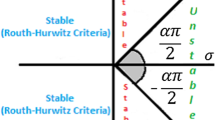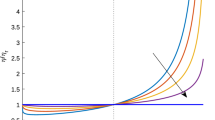Abstract
In this paper, we introduce the fractional analog of a chemical model arouse from a mathematical paradox attributed to Dietrich Braess. Two basic examples which serve fractional kinetic models as better suited models to the real data sets than the integer-order counterparts are given. Existence and uniqueness of the rebuilt model’s solutions are proved. It is shown that asymptotic stability conditions of the solutions are provided. A comparison is made between two different solution methods and numerical simulations are also presented to exemplify the mathematical outcomes.








Similar content being viewed by others
References
Abbas S, Mahto L, Favini A, Hafayed M (2016) Dynamical study of fractional model of allelopathic stimulatory phytoplankton species. Differ Equ Dyn Syst 24(3):267–280
Ahmed E, El-Sayed AMA, El-Saka HAA (2007) Equilibrium points, stability and numerical solutions of fractional-order predator-prey and rabies models. J Math Anal Appl 325:542
Almeida R, Bastos NRO, Monteiro MTT (2016) Modeling some real phenomena by fractional differential equations. Math Methods Appl Sci 39:4846–4855
Ameen I, Novati P (2017) The solution of fractional order epidemic model by implicit Adams methods. Appl Math Model 43:78–84
Ansari MA, Arora D (2016) Chaos control and synchronization of fractional order delay-varying computer virus propagation model. Math Methods Appl Sci 39:1197–1205
Area et al (2015) On a fractional order Ebola epidemic model. Adv Differ Equ 2015:278. doi:10.1186/s13662-015-0613-5
Ariza-Hernandez FJ, Sanchez-Ortiz J, Arciga-Alejandre MP, Vivas-Cruz LX (2017) Bayesian analysis for a fractional population growth model. J Appl Math 2017:9654506. doi:10.1155/2017/9654506
Arnaut L, Formosinho S, Burrows H (2007) Chemical kinetics: from molecular structure to chemical reactivity. Elsevier, Amsterdam
Arshad et al (2017) Effects of HIV infection on CD4+ T-cell population based on a fractional-order model. Adv Differ Equ 2017:92
Balcı MA (2016) Fractional virus epidemic model on financial networks. Open Math 14:1074–1086
Balcı MA (2017) Time fractional capital-induced labor migration model. Physica A 477:91–98
Baleanu D, Golmankhaneh AK, Golmankhaneh AK, Nigmatullin RR (2010) Newtonian law with memory. Nonlinear Dyn 60(1–2):81–86
Bonilla B, Rivero M, Trujillo JJ (2007) On systems of linear fractional differential equations with constant coefficients. Appl Math Comput 187(1):68
Braess D, Nagurney A, Wakolbinger T (2005) On a paradox of traffic planning. Transp Sci 39:446
Carvalho A, Pinto CMA (2017) A delay fractional order model for the co-infection of malaria and HIV/AIDS. Int J Dyn Control 5:168–186
Constantinescu D, Stoicescu M (2011) Phys AUC 21:114
Debnath L (2003) Recent applications of fractional calculus to science and engineering. Int J Math Math Sci 2003(54):3413–3442. doi:10.1155/S0161171203301486
Demirci E (2017) A fractional order model for obesity epidemic in a non-constant population. Adv Differ Equ 2017:79
Demirci E, Özalp N (2011) A fractional order SEIR model with vertical transmission. Math Comput Model 54:1
Demirci E, Özalp N (2012) A method for solving differential equations of fractional order. J Comput Appl Math 236:2754
Diethelm K (2010) The analysis of fractional differential equations: an application-oriented exposition using differential operators of Caputo type. In: Morel J-M, Takens F, Teissier B (eds) Lecture notes in mathematics. Springer, Berlin
Ding Y, Ye H (2009) A fractional-order differential equation model of HIV infection of CD4+T-Cells. Math Comput Model 50:386
Du M, Wang Z, Hu H (2013) Measuring memory with the order of fractional derivative. Sci Rep 3:3431. doi:10.1038/srep03431
Elsadany AA, Matouk AE (2015) Dynamical behaviors of fractional-order Lotka–Volterra predator–prey model and its discretization. J Appl Math Comput 49:269–283. doi:10.1007/s12190-014-0838-6
Fogler HS (2006) Elements of chemical reaction engineering, 4th edn. Prentice Hall PTR, Upper Saddle River
Ghaziani RK et al (2016) Stability and dynamics of a fractional order Leslie–Gower prey–predator model. Appl Math Model 40:2075–2086
Glöckle W, Nonnenmacher TF (1995) A fractional calculus approach to self-similar protein Dynamics. Biophys J 68(1):46
Goulart AGO et al (2017) Fractional derivative models for atmospheric dispersion of pollutants. Physica A 477:9–19
Handam AH, Freihat AA, Zurigat M (2015) The multi-step homotopy analysis method for solving fractional-order model for HIV infection of CD4+T cells. Proyecc J Math 34(4):307–322
Kilbas AA, Srivastava HM, Trujillo JJ (2006) Theory and applications of fractional differential equations. Elsevier, Amsterdam
Laidler KJ (1963) Reaction kinetics: volume 1-homogeneous gas reactions. Pergamon Press, New York
Lepore DM, Baratt C, Schwartz PM (2011) Computational models of chemical systems inspired by braess’ paradox. J Math Chem 49:356
Magin RL (2004) Fractional calculus in bioengineering. Crit Rev Biomed Eng 32(1):104
Magin RL (2006) Fractional calculus in bioengineering. Begell House Publishers Inc, Connecticut
Magin RL, Nigmatullin RR (2013) Fractional dynamics. Cent Eur J Phys 11(6):615
Matignon D (1996) Stability results for fractional differential equations with applications to control processing. In: Computational engineering in systems applications, vol 2. Lille, France, p 963
Metzler R, Schick W, Kilian H-G, Nonnenmacher TF (1995) Relaxation in filled polymers: a fractional calculus approach. J Chem Phys 103(16):7180
Miller KS, Ross B (1993) An introduction to the fractional calculus and fractional differential equations. Wiley, New York
Nigmatullin RR, Mehaute AL (2005) Is there geometrical/physical meaning of the fractional integral with complex exponent? J Non Cryst Solids 351:2888
Nigmatullin RR, Nelson SO (2006) Recognition of the “fractional” kinetics in complex systems: dielectric properties of fresh fruits and vegetables from 0.01 to 1.8 GHz. Signal Process 86:2744
Nigmatullin RR, Osokin SI, Smith G (2003) The justified data-curve fitting approach: recognition of the new type of kinetic equations in fractional derivatives from analysis of raw dielectric data. J Phys D Appl Phys 36:2281
Odibat ZM (2010) Analytic study on linear systems of fractional differential equations. Comput Math Appl 59:1171
Ozalp N, Koca I (2012) A fractional order nonlinear dynamical model of interpersonal relationships. Adv Differ Equ 2012(1):189
Pan M et al (2016) Modeling heat transport in nanofluids with stagnation point flow using fractional calculus. Appl Math Model 40:8974–8984
Penchina CM, Penchina LJ (2003) The Braess paradox in mechanical, traffic, and other networks. Am J Phys 71:479
Pinto CMA, Carvalho ARM (2017) A latency fractional order model for HIV dynamics. J Comput Appl Math 312:240–256
Podlubny I (1999) Fractional differential equations. Academic Press, New York
Podlubny I (2002) Geometric and physical interpretation of fractional integration and fractional differentiation. Fract Calc Appl Anal 5(4):367–386
Rostamy D, Mottaghi E (2016) Stability analysis of a fractional-order epidemics model with multiple equilibriums. Adv Differ Equ 2016:170
Samko G, Kilbas A, Marichev O (1993) Fractional integrals and derivatives: theory and applications. Gordon and Breach, Amsterdam
Sarwar S, Rashidi MM (2016) Approximate solution of two-term fractional-order diffusion, wave-diffusion, and telegraph models arising in mathematical physics using optimal homotopy asymptotic method. Waves Random Complex Media 26(3):365–382. doi:10.1080/17455030.2016.1158436
Shen C, Zhou H, Yang L (2016) Existence and nonexistence of positive solutions of a fractional thermostat model with a parameter. Math Methods Appl Sci 39:4504–4511
Sofuoglu Y, Ozalp N (2017) Fractional order bilingualism model without conversion from dominant unilingual group to bilingual group. Differ Equ Dyn Syst 25(1):1–9
Tarasov VE (2013) Review of some promising fractional physical models. Int J Mod Phys B 27(9):1330005
Vicente B, Nori M, Fogler HS (2007) Solutions manual for elements of chemical reaction engineering. Prentice Hall, Upper Saddle River
Weisstein EW (2013) Root-mean-square. From MathWorld—A Wolfram Web Resource. http://mathworld.wolfram.com/Root-Mean-Square.html
Wright MR (1999) Fundamental chemical kinetics: an explanatory introduction to the concepts. Woodhead Publishing, Cambridge
Xianbing C et al (2016) Fractional-order model of the disease psoriasis: a control based mathematical approach. J Syst Sci Complex 29:1565–1584
Xu H (2009) Analytical approximations for a population growth model with fractional order. Commun Nonlinear Sci Numer Simul 14:1978
Zhang S, Cai B, Xu B (2015) Variable separation method for nonlinear time fractional biological population model. Int J Numer Methods Heat Fluid Flow 25(7):1531–1541. doi:10.1108/HFF-03-2013-0092
Acknowledgements
This work is supported by the Scientific Research Unit of Ankara University with the grant number 17L0430006.
Author information
Authors and Affiliations
Corresponding author
Additional information
Communicated by José Tenreiro Machado.
Rights and permissions
About this article
Cite this article
Mizrak, O.O., Ozalp, N. Fractional analog of a chemical system inspired by Braess’ paradox. Comp. Appl. Math. 37, 2503–2518 (2018). https://doi.org/10.1007/s40314-017-0462-9
Received:
Revised:
Accepted:
Published:
Issue Date:
DOI: https://doi.org/10.1007/s40314-017-0462-9
Keywords
- Kinetic models
- Chemical networks
- Braess’ paradox
- Fractional derivative
- Existence and uniqueness
- Stability




